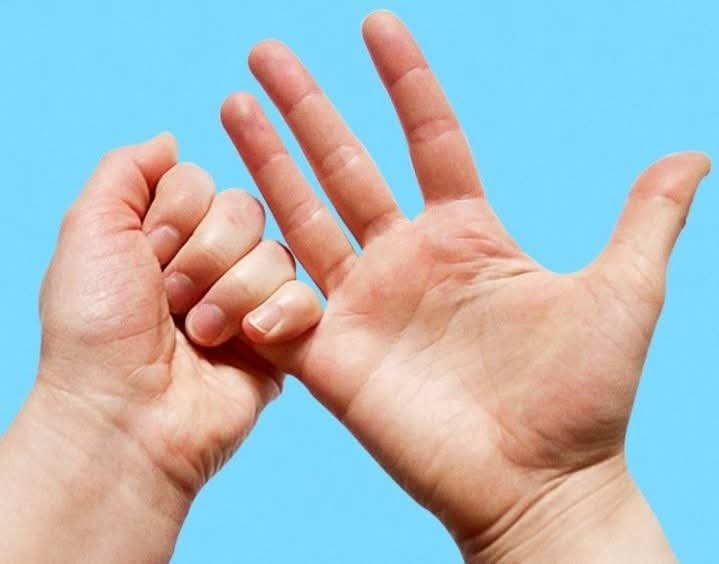ADVERTISEMENT
an often affect digestion.
For Complete Cooking STEPS Please Head On Over To Next Page Or Open button (>) and don’t forget to SHARE with your Facebook friends
**How to Massage the Thumb:**
– Using your opposite hand, apply gentle pressure to the thumb and rub in small circles.
– Focus on the base and tip of the thumb for deeper relaxation.
– Massage for 1-2 minutes to stimulate the digestive system.
#### 2. **Index Finger: The Kidneys and Bladder**
The **index finger** corresponds to the **kidneys** and **bladder**. Massaging the index finger is believed to support urinary health, improve fluid balance, and relieve tension related to kidney or bladder discomfort. It can also help with symptoms like frequent urination or lower back pain associated with kidney issues.
**How to Massage the Index Finger:**
– Apply light pressure to the index finger, starting from the base and moving toward the tip.
– Massage in small, circular motions to stimulate the kidney and bladder regions.
– Use your thumb and forefinger to gently pinch and knead the finger to release tension.
#### 3. **Middle Finger: The Liver and Gallbladder**
The **middle finger** is connected to the **liver** and **gallbladder**. If you’ve been feeling sluggish, experiencing digestive issues, or suffering from a general lack of energy, massaging your middle finger may help. The liver plays a vital role in detoxification, and massaging this finger can encourage circulation and help your body cleanse itself naturally.
**How to Massage the Middle Finger:**
– Gently rub the middle finger starting from the base and working your way to the tip.
– Apply pressure in circular motions to stimulate the liver and gallbladder.
– Focus on the knuckles and tip for relief from digestive or liver-related issues.
#### 4. **Ring Finger: The Heart and Circulatory System**
The **ring finger** is linked to the **heart** and the **circulatory system**. If you’re feeling anxious, stressed, or even physically drained, massaging your ring finger can help calm your heart and blood circulation. It’s also believed to be helpful for relieving emotional tension, including stress or grief.
**How to Massage the Ring Finger:**
– Start by gently pressing the base of the finger with your thumb and index finger.
– Use circular motions to massage the entire length of the ring finger, from base to tip.
– Focus on deep breathing while you massage to encourage relaxation of the heart and circulatory system.
#### 5. **Little Finger: The Small Intestine and Heart**
The **little finger** is connected to the **small intestine** and the **heart**. Massage of the pinky can be helpful for alleviating digestive discomfort, improving the absorption of nutrients, and even improving circulation. It’s also associated with relieving tension in the heart area, which can help with both physical and emotional stress.
**How to Massage the Little Finger:**
– Apply gentle pressure with your thumb and index finger to the base of the little finger.
– Slowly work your way to the tip of the finger, applying light pressure and circular motions.
– Focus on relaxing your breath while massaging, especially if you are feeling emotionally tense.
### Benefits of Finger Massages
Finger massages can provide a wide array of health benefits. Here’s why you should incorporate this simple technique into your wellness routine:
– **Boost Circulation**: Gentle pressure on your fingers encourages blood flow, which helps the body flush out toxins and maintain healthy organ function.
– **Reduce Stress**: Stimulating pressure points in your fingers can trigger the relaxation response, lowering cortisol levels, and relieving stress.
– **Pain Relief**: Regular finger massages may help alleviate pain associated with the digestive system, headaches, back pain, and even menstrual cramps.
– **Digestive Health**: By targeting the thumb, which is linked to the stomach and digestive system, you can improve digestion and reduce discomfort.
– **Improved Organ Function**: Reflexology works to stimulate organ function naturally by massaging the corresponding pressure points in your fingers.
– **Emotional Balance**: The ring finger and pinky, connected to the heart, are particularly useful for relieving emotional tension, improving mood, and promoting emotional healing.
### How to Do a Finger Massage
Massaging your fingers is easy and doesn’t require any special tools. Here’s a quick guide:
1. **Relax**: Sit in a comfortable position and take a few deep breaths to relax.
2. **Use Your Opposite Hand**: Use your thumb and index finger to gently massage each finger of your opposite hand.
3. **Apply Pressure**: Begin with gentle pressure and gradually increase it as you feel more comfortable. Focus on the base, middle, and tips of each finger.
4. **Use Circular Motions**: Massage in small, circular motions to stimulate blood flow and energy in the corresponding organ.
5. **Breathe**: Focus on your breath while massaging. Deep, slow breaths will help you relax and improve the benefits of the massage.
6. **Repeat**: Spend 1-2 minutes massaging each finger, and repeat the process as needed.
### Final Thoughts
Massage isn’t just about relaxation—it’s also a powerful tool for promoting health and well-being. By understanding how your fingers correspond to different organs in the body, you can use finger massages to address a variety of health concerns, from digestive issues to emotional stress and even heart health.
Incorporating finger massages into your daily routine is an easy and effective way to support your body’s natural healing abilities. Whether you’re looking to relax, alleviate specific symptoms, or just feel more balanced, giving yourself a finger massage can be a simple, yet transformative self-care practice.
So, the next time you’re feeling a little off, try massaging your fingers. Your body (and your organs) will thank you!
